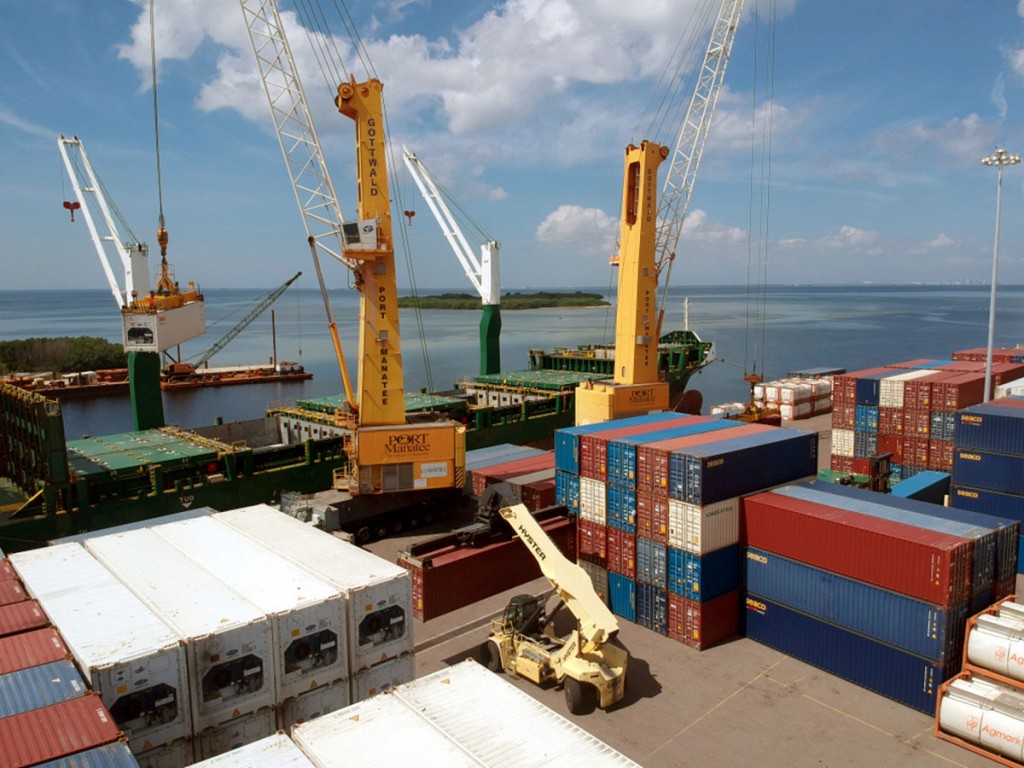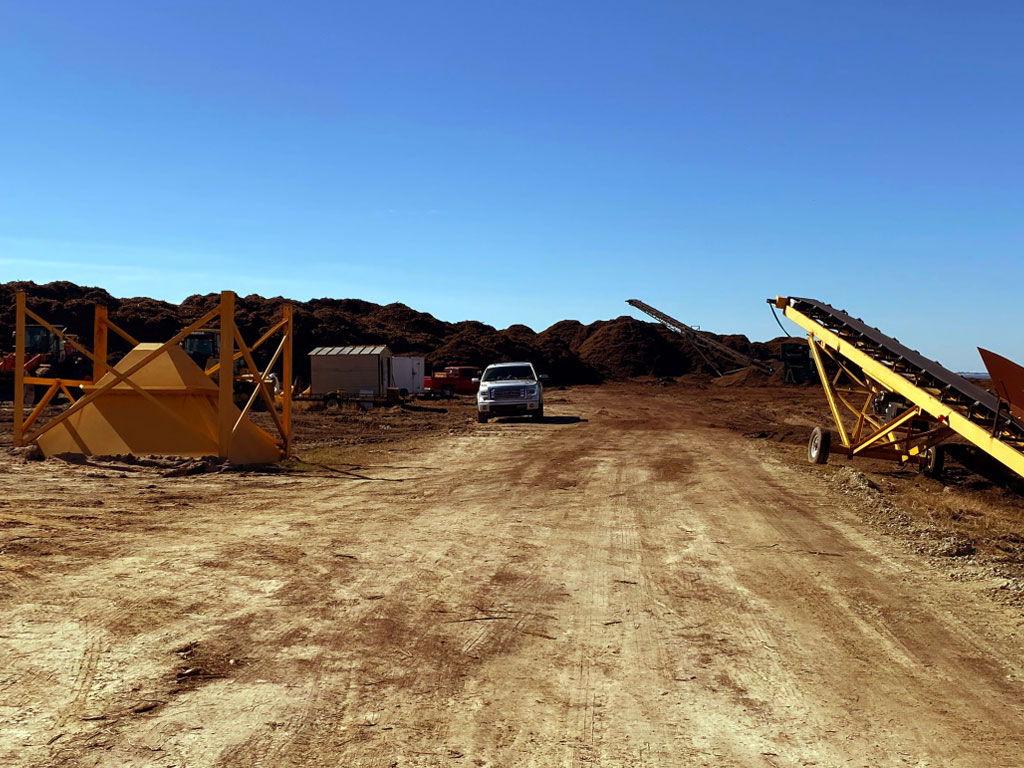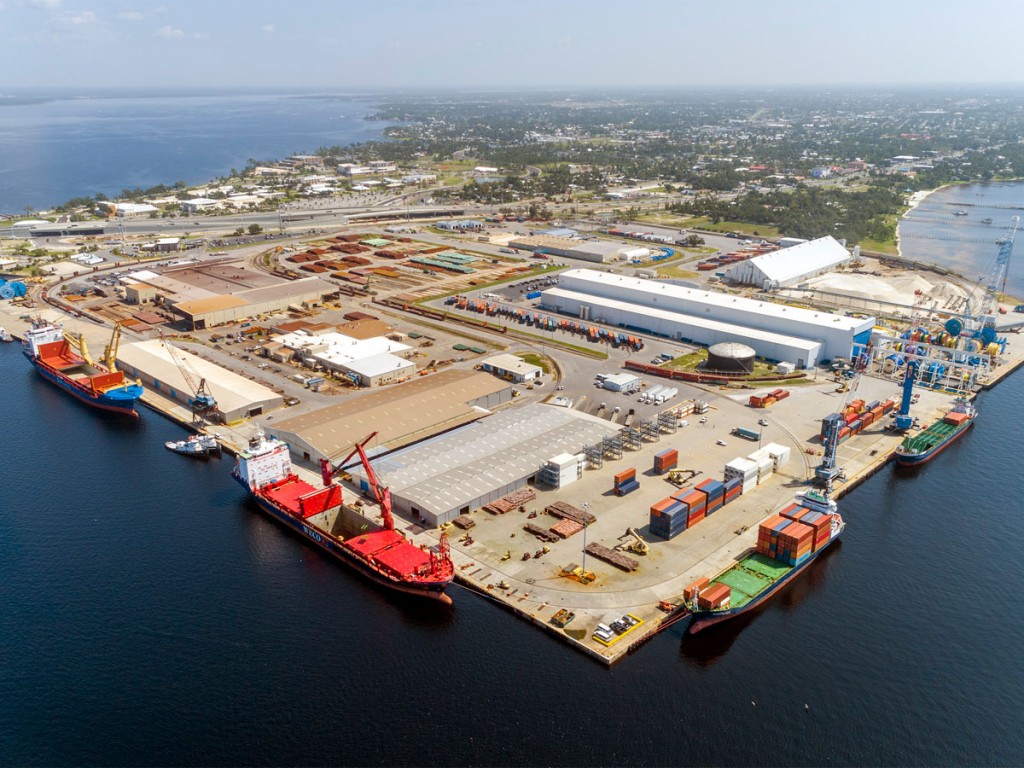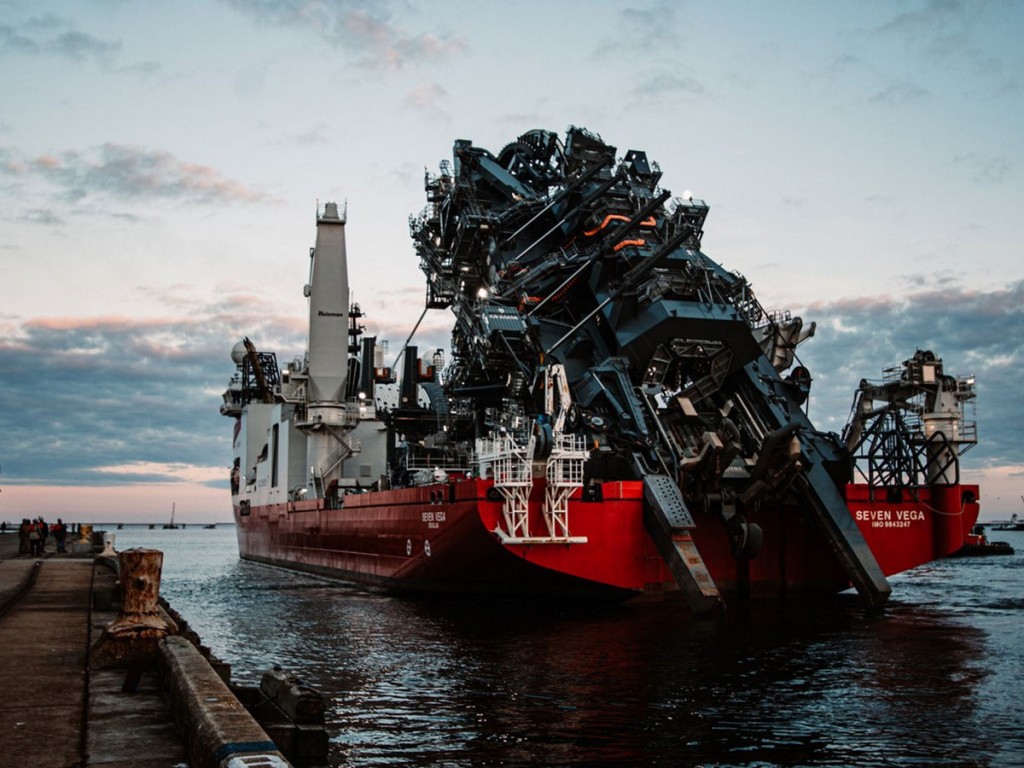From moving containerized produce imports and wood pellet exports to hosting operations supporting space exploration and ocean floor pipe-laying, ports on the Gulf Coast of Florida are home to a broad array of activities.
Unslowed by COVID-19 and landfalls of hurricanes, the diverse ports of the Florida West Coast and Panhandle have continued to move healthy volumes of cargo while advancing infrastructure projects to efficiently accommodate future business.
Beginning along Tampa Bay and moving north and then westward, here’s what’s happening at Florida seaports along the Gulf of Mexico:

Port Manatee
The viral pandemic hasn’t dampened activity at Port Manatee, near Tampa Bay’s entrance. Indeed, a record 88,466 twenty-foot-equivalent container units crossed the Manatee County port’s docks in the fiscal year ended Sept. 30, 2020, up 54.6 percent from the preceding 12-month period.
Driving the vibrant container trade are Port Manatee-based World Direct Shipping, importing produce and other goods from Mexico since 2014, and Fresh Del Monte Produce, in its fourth decade bringing Latin American fruit to its bustling Southeast distribution center, now on new ecofriendly refrigerated containerships.
To help facilitate efficient handling of surging volumes, Port Manatee is advancing toward anticipated mid-2021 completion an $8.3 million project to nearly double, to 19.3 acres, the size of its dockside container yard. That undertaking, boosted by a state grant, is the cornerstone of a two-year, $38 million capital enhancement initiative at the diverse port, which serves as a preferred gateway to burgeoning Southwest and Central Florida markets while being promoted as the closest U.S. deepwater seaport to the expanded Panama Canal. A major berth expansion could get under way later this year.

Port Tampa Bay
With numerous service additions over the past couple of years, Port Tampa Bay’s container terminal, operated by Ports America, keeps growing as a prime gateway for hundreds of distribution centers lining the dynamic Interstate 4 corridor between Tampa and Orlando.
Joining recently added trans-Pacific boxship services at Port Tampa Bay are a pair of offerings crossing the Gulf of Mexico, furnishing competitive alternatives to trucking. In December, longtime Port Tampa Bay partner ZIM Integrated Shipping Services launched a weekly container service to and from Mexico’s Port of Altamira, while Work Cat commenced weekly sailings moving 53-foot-long containers between Tampa and the Port of Brownsville, Texas, just north of the U.S.-Mexico border.
With the help of a $19.8 million U.S. Department of Transportation grant, Port Tampa Bay, Florida’s longtime busiest port in terms of total cargo tonnage, is continuing to expand terminal capacity, with efforts under way to add more cranes and other container-handling equipment, greater paved storage area, a new gate complex and further transload warehousing, all with an eye toward enhancing supply chain efficiencies for Florida importers and exporters.

Port of Port St. Joe
Woody material left behind from when Hurricane Michael struck the Florida Panhandle back in October 2018 is providing fodder for an operation officials of the Port St. Joe Port Authority are hoping will furnish an opportunity for a long-awaited rebound for maritime facilities that have languished since the late 1990s, when St. Joe Paper Co. closed its signature paper mill and box plant.
Authority officials announced in January that an agreement has been reached with Perry, Georgia-based Twin Rivers Land and Timber to begin exporting woody biomass from the Port of Port St. Joe, with shipments to Honduras beginning as early as March. The wood chip material is to be used in generating electrical power for multiple Honduran textile plants.
Not only does the operation bode to revive the port, bringing 10 on-port jobs plus employing more than 100 in timber-related work inland, but it also should make productive use of much of the unsightly nonmerchantable timber still left behind in the hurricane-devastated Gulf County area while helping mitigate some of the high cleanup costs local landowners continue to face.

Port Panama City
A bit to the west, Port Panama City and the U.S. Army Corps of Engineers have completed the East Channel deepening project, providing 36-foot-deep channel access for the Panhandle port’s new forest products facility at its East Terminal. The facility handles G2 Ocean pulp and paper exports to the Mediterranean, North Europe, and Asia. The port also receives imported lumber from North Europe, carried by Ultrabulk.
At its longstanding West Terminal, Port Panama City is experiencing solid growth in container trade with Mexico and has ordered a new mobile harbor crane for delivery in April. Under construction is a 70,000-square-foot container freight station, to feature 10 truck bays and be supported by rail.
Announcement of a start date is imminent for construction of a 20,000-ton-capacity wood pellet storage dome, which aims to bring the port’s total such storage capability up to 50,000 tons. The port, which is seeing retirement of Wayne Stubbs from the executive director role he has held for 20 years, has also begun the design work for a $4.5 million expansion of its off-port intermodal distribution facility.

Port of Pensacola
When it comes to diversity of activities, few ports outdo Northwest Florida’s Port of Pensacola. The city-owned port – featured last fall in an episode of ION Television’s “World’s Greatest” – was winter training hub for New York Yacht Club American Magic’s Patriot as it prepared for the 36th America’s Cup, and it continues to host aquaculture undertakings of Pensacola Bay Oysters, in addition to being home to numerous somewhat more traditional port functions.
Despite the pandemic and the September assault of Hurricane Sally, the Port of Pensacola, buoyed by increasing moves of GE Wind Energy units, more than doubled total tonnage throughput in its fiscal year ended Sept. 30, 2020, compared with the preceding 12-month period.
The port has extended leases with such tenants as Cemex and Offshore Inland Marine while inking a new pact with pleasure craft builder Streamline Boats. Also, the port is home to the 630-foot-long Jacklyn, being converted into a rocket landing platform vessel by space exploration company Blue Origin, and to maintenance, repair and overhaul operations, including of Subsea 7, with 475-foot-long pipe-laying vessel Seven Vega.





